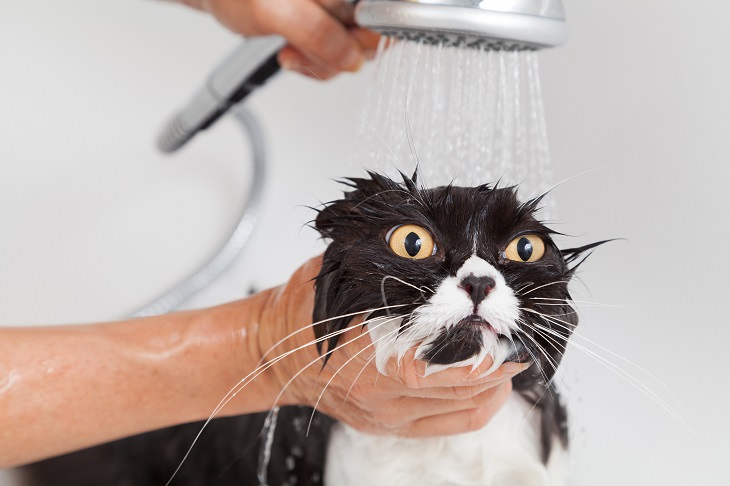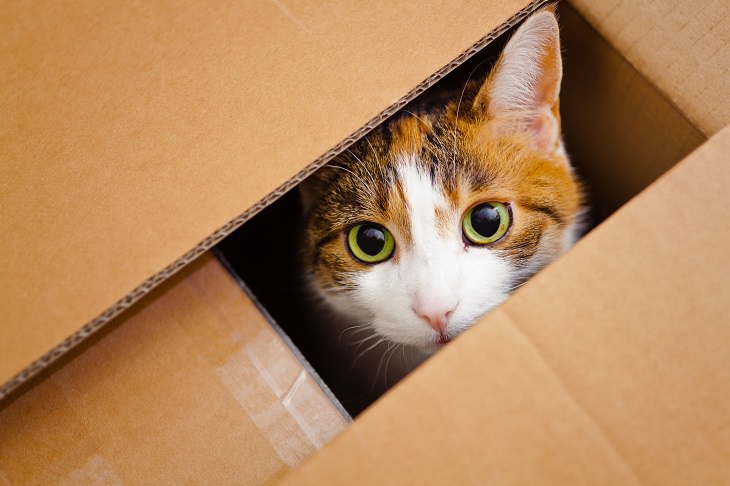

It’s no secret that domestic cats dislike being in water or getting wet. On the other hand, most dogs can’t get enough of it. Kelley Nollen, a director of behavior programs for the College of Veterinary Medicine at Cornell University, suggests that the reason for this might be because a cat’s fur takes a lot longer to dry than that of a dog. Or maybe it’s because cats prefer to have all four feet on solid ground and do not appreciate the feeling of floating in water.
When it comes to dogs, Suzanne Hetts, a wildlife biologist with Animal Behavior Associates in Colorado, says most dogs are introduced to water when they’re young, while cats are not. Moreover, some dog breeds, such as the Irish water spaniel and Portuguese water dog, are bred to work in water and have body types that are suitable for swimming.
Why Do Cats Stretch So Much?
Andrew Cuff, a postdoctoral researcher of anatomy at the Royal Veterinary College in London, suggests that cats love to stretch largely for the same reason the most people do – it feels good and increases blood flow to the muscles. Cats sleep for 12-16 hours a day, meaning that they’re inactive for large periods of time. When cats are inactive, their blood pressure drops and stretching can help to reverse this.
Moreover, stretching can also help flush out toxins that have built up in the body during periods of inactivity. To add to this, when a cat stretches, it readies its muscles for activity, such as chasing a mouse.

Leslie Irvine, author of “If You Tame Me: Understanding Our Connection with Animals,” explains that this curious behavior is actually hardwired in dogs from prehistoric times.
Our dogs’ ancestors used to walk in circles to make a nest – an area with stomped-down grass where they could rest. This behavior may have also helped to drive out snakes or large insects that might have bothered them. To add to this, a nest would mark the dog’s territory, telling other dogs to keep away.
Why Do Cats Bring Home Dead Animals?
Even though most pet cats have access to all the food they could need, these natural-born hunters still bring home dead mice, birds, and other small animals that they’ve killed during their adventures.
This is because wild cats usually eat several small meals per day, and that instinct didn’t disappear when they became domesticated over 10,000 years ago. Moreover, mother cats in the wild catch small prey and bring it home to help teach their young how to eat. Domestic cats are often spayed, meaning they can’t have kittens, but that won’t stop them trying to pass on their hunting wisdom.
In fact, according to veterinarian Dr. Marty Becker, your cat might think you’re a kitten that needs feeding or may just want to thank you for providing her with food over the years.
Do Dogs Sweat?
Dogs do sweat, but not like people do.
Yana Kamberov, an assistant professor of genetics at the University of Pennsylvania, explains that when humans sweat we rely on the eccrine sweat glands that are found all over the body. The sweat wets the skin and then evaporates, cooling the body down. This allows us to continue walking, trekking, or running without overheating.
In stark contrast, Catherine Carrier, a vet and animal operations senior manager at Covance Laboratories, a contract research facility that partners with pharmaceutical companies, explains that dogs only have sweat glands on their paws and noses. These sweat glands aren’t enough to cool dogs down and that is why they pant after exercise.

Anyone who owns a cat knows that as soon as a box enters your home, your cat will be sitting in it in no time at all. But why do they love these confined spaces?
Stephen Zawistowski, a science adviser for the American Society for the Prevention of Cruelty to Animals, suggests that this behavior is likely instinctive. in the wild, enclosed spaces help cats hide from predators and stalk prey.
A box can help cats see what’s coming at them, allowing them to scan the area without being seen. What’s more, it the cat leaves the box to chase some prey or a toy, it can always return to its safe zone afterwards.
Why Do Dogs Wag Their Tails?
Is it true that your beloved canine friend wags his tail out of happiness? Well, sort of. Dogs do wag their tails as a sign of contentment, but this is not always the case. Back in 2007, researchers found that whether the tail is swishing on the right or left side of the dog’s body has meaning: A tail that’s skewed to the right indicates positive emotions, while a tail that is skewed to the left suggests negative ones.
This difference may be linked to the differences found in the right and left hemispheres of a dog’s brain. Furthermore, research published in 2013 in the journal Current Biology revealed that a right-wagging tail tends to relax canine passers-by, while a left wag seems to stress out other dogs.
Why Are Cats Such Picky Eaters?
When your cat turns its nose up at the food you have placed in front of her, don’t feel bad. Cats are picky eaters and this seemingly snobby behavior may be hardwired into a feline’s brain.
Rather than judging the food on its smell, taste, and feel, cats may be doing some math in their heads as they need foods with a 1 to 0.4 ration of protein to fat, according to research published in June 2016 in the journal Royal Society Open Science.
However, how your cat can detect this nutrient ratio remains a mystery…for now.
Source: livescience
Images: depositphotos